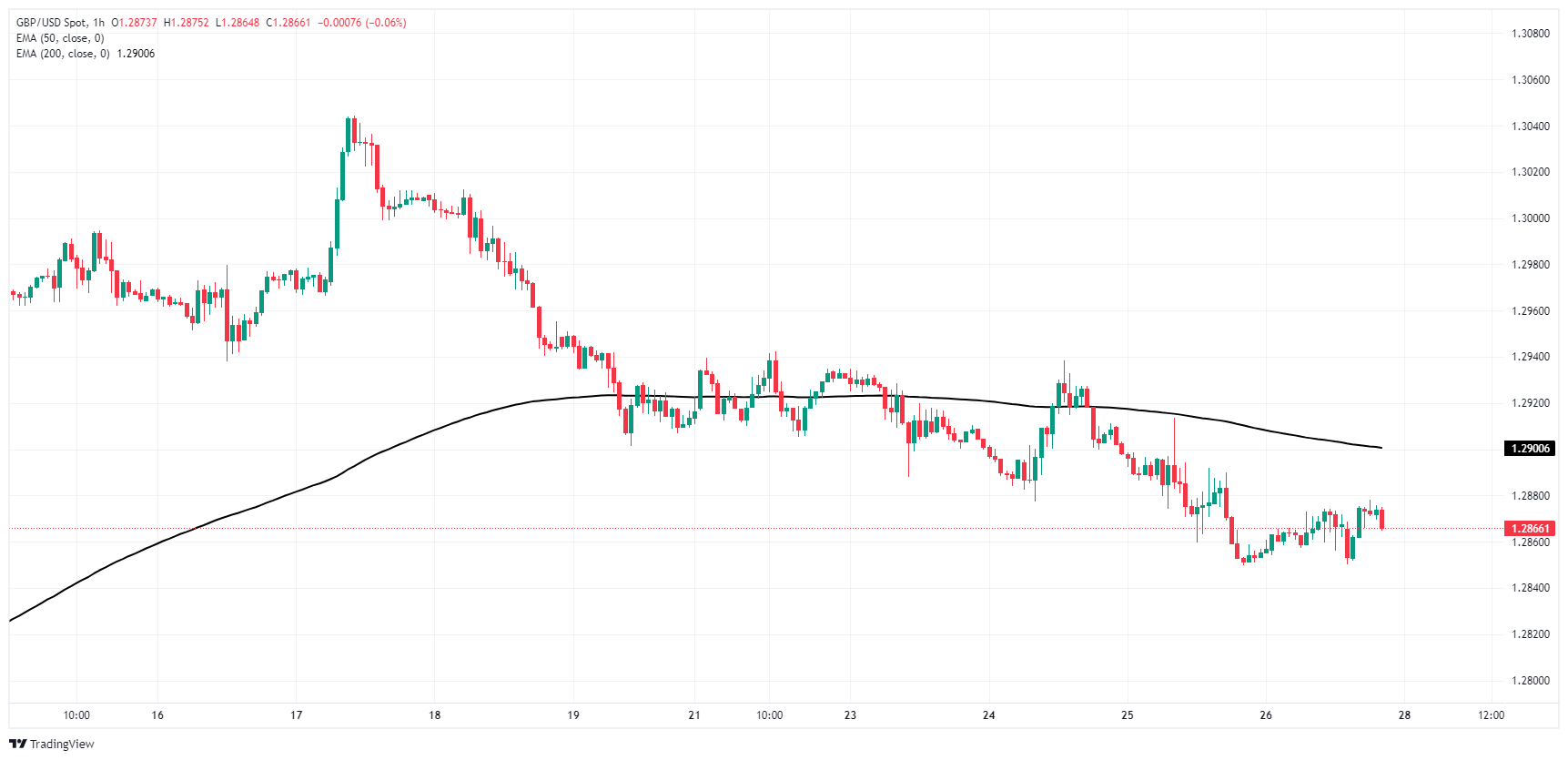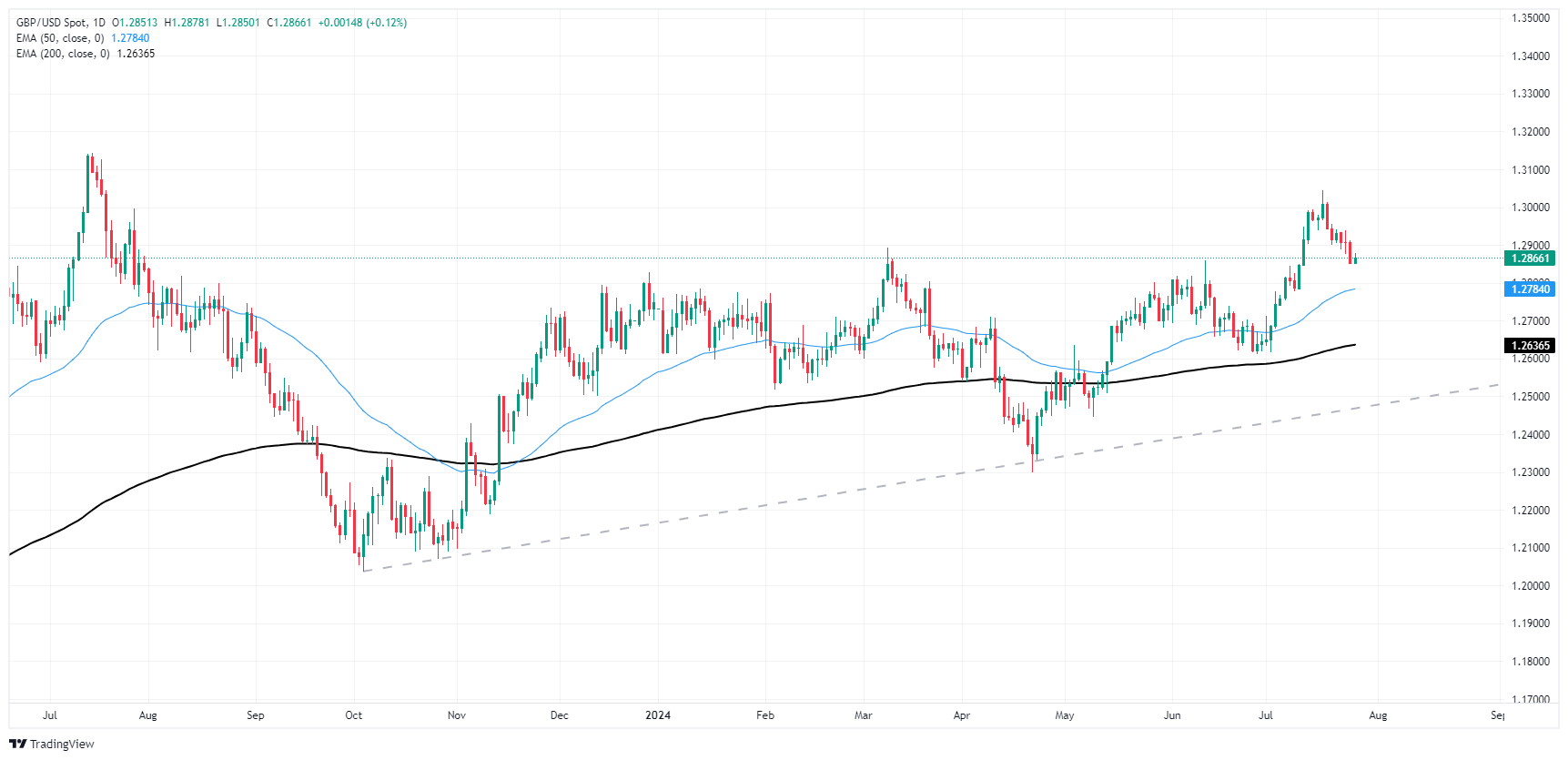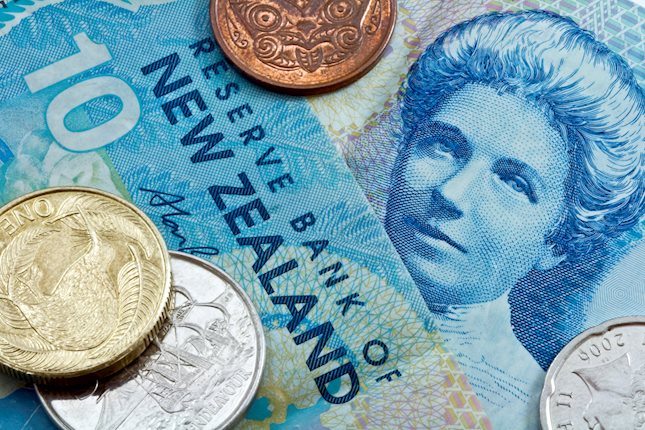- GBP/USD failed to make meaningful headway on Friday.
- The Pound Sterling has been floundering ahead of next BoE rate call.
- BoE set to deliver a quarter-point rate cut next Thursday.
GBP/USD floundered on Friday, climbing a scant 0.13% on the day as the Pound Sterling gets weighed down by broad-market expectations of a rate cut from the Bank of England (BoE) next week. The pair wraps up the trading week down one-half of one percent, adding a second straight week of downside momentum as the pair pulls back from last week’s 12-month high above 1.3000.
Forecasting the Coming Week: All eyes are on the Fed’s decision and the NFP
The BoE is set to deliver its first rate cut since March 2020 on Thursday. The UK’s main benchmark rate is expected to shift down 25 basis points to 5.0% from the current 5.25%. Before that, the Federal Reserve (Fed) is due to deliver its own July rate call, and investors are broadly expecting the US central bank to keep rates pinned for one more meeting before kicking off a rate-cutting cycle in September.
The core US PCE inflation remained steady at 2.6% year-over-year in June, going against the median market forecast of a decrease to 2.5%. Additionally, near-term PCE inflation accelerated month-over-month in June, increasing to 0.2% from the forecasted 0.1%.
The University of Michigan's Consumer Sentiment Index dropped to an eight-month low of 66.4 in July, less than the anticipated 66.0 but still lower than the previous reading of 68.4. The UoM 5-year Consumer Inflation Expectations also rose to 3.0% in July from the previous 2.9%.
Despite indications of potential inflationary pressures, the markets chose not to worry about the figures and instead shifted towards a risk-on sentiment, holding out hope for a rate cut in September. According to the CME's FedWatch Tool, rate markets are still pricing in at least a 25-basis-point rate cut by the Federal Open Market Committee (FOMC) on September 18, with 100% odds of a hold on July 31. Additionally, there is a 12% chance of a 50-bps double cut in September by a contingent that is particularly hopeful for a rate cut.
British Pound PRICE This week
The table below shows the percentage change of British Pound (GBP) against listed major currencies this week. British Pound was the strongest against the Australian Dollar.
| USD | EUR | GBP | JPY | CAD | AUD | NZD | CHF | |
|---|---|---|---|---|---|---|---|---|
| USD | 0.24% | 0.36% | -2.29% | 0.87% | 2.11% | 2.20% | -0.44% | |
| EUR | -0.24% | 0.10% | -2.55% | 0.58% | 1.90% | 1.87% | -0.74% | |
| GBP | -0.36% | -0.10% | -2.75% | 0.46% | 1.80% | 1.76% | -0.88% | |
| JPY | 2.29% | 2.55% | 2.75% | 3.27% | 4.57% | 4.52% | 1.80% | |
| CAD | -0.87% | -0.58% | -0.46% | -3.27% | 1.32% | 1.30% | -1.32% | |
| AUD | -2.11% | -1.90% | -1.80% | -4.57% | -1.32% | -0.03% | -2.63% | |
| NZD | -2.20% | -1.87% | -1.76% | -4.52% | -1.30% | 0.03% | -2.56% | |
| CHF | 0.44% | 0.74% | 0.88% | -1.80% | 1.32% | 2.63% | 2.56% |
The heat map shows percentage changes of major currencies against each other. The base currency is picked from the left column, while the quote currency is picked from the top row. For example, if you pick the British Pound from the left column and move along the horizontal line to the US Dollar, the percentage change displayed in the box will represent GBP (base)/USD (quote).
GBP/USD technical outlook
Cable has fallen back below the 1.2900 handle after backsliding from a 12-month peak near 1.3045 set last week. The pair is down around 1.5% peak-to-trough, but near-term momentum still leans in favor of buyers as price action holds on the high side of the 200-day Exponential Moving Average (EMA) at 1.2636.
Short pressure will be looking to force bids down below the last swing low near 1.2600, while renewed bidding could step in if GBP/USD declines far enough to tap a rising trendling drawn from last October’s bottom bids near 1.2037.
GBP/USD hourly chart
GBP/USD daily chart
Pound Sterling FAQs
The Pound Sterling (GBP) is the oldest currency in the world (886 AD) and the official currency of the United Kingdom. It is the fourth most traded unit for foreign exchange (FX) in the world, accounting for 12% of all transactions, averaging $630 billion a day, according to 2022 data. Its key trading pairs are GBP/USD, aka ‘Cable’, which accounts for 11% of FX, GBP/JPY, or the ‘Dragon’ as it is known by traders (3%), and EUR/GBP (2%). The Pound Sterling is issued by the Bank of England (BoE).
The single most important factor influencing the value of the Pound Sterling is monetary policy decided by the Bank of England. The BoE bases its decisions on whether it has achieved its primary goal of “price stability” – a steady inflation rate of around 2%. Its primary tool for achieving this is the adjustment of interest rates. When inflation is too high, the BoE will try to rein it in by raising interest rates, making it more expensive for people and businesses to access credit. This is generally positive for GBP, as higher interest rates make the UK a more attractive place for global investors to park their money. When inflation falls too low it is a sign economic growth is slowing. In this scenario, the BoE will consider lowering interest rates to cheapen credit so businesses will borrow more to invest in growth-generating projects.
Data releases gauge the health of the economy and can impact the value of the Pound Sterling. Indicators such as GDP, Manufacturing and Services PMIs, and employment can all influence the direction of the GBP. A strong economy is good for Sterling. Not only does it attract more foreign investment but it may encourage the BoE to put up interest rates, which will directly strengthen GBP. Otherwise, if economic data is weak, the Pound Sterling is likely to fall.
Another significant data release for the Pound Sterling is the Trade Balance. This indicator measures the difference between what a country earns from its exports and what it spends on imports over a given period. If a country produces highly sought-after exports, its currency will benefit purely from the extra demand created from foreign buyers seeking to purchase these goods. Therefore, a positive net Trade Balance strengthens a currency and vice versa for a negative balance.
Information on these pages contains forward-looking statements that involve risks and uncertainties. Markets and instruments profiled on this page are for informational purposes only and should not in any way come across as a recommendation to buy or sell in these assets. You should do your own thorough research before making any investment decisions. FXStreet does not in any way guarantee that this information is free from mistakes, errors, or material misstatements. It also does not guarantee that this information is of a timely nature. Investing in Open Markets involves a great deal of risk, including the loss of all or a portion of your investment, as well as emotional distress. All risks, losses and costs associated with investing, including total loss of principal, are your responsibility. The views and opinions expressed in this article are those of the authors and do not necessarily reflect the official policy or position of FXStreet nor its advertisers. The author will not be held responsible for information that is found at the end of links posted on this page.
If not otherwise explicitly mentioned in the body of the article, at the time of writing, the author has no position in any stock mentioned in this article and no business relationship with any company mentioned. The author has not received compensation for writing this article, other than from FXStreet.
FXStreet and the author do not provide personalized recommendations. The author makes no representations as to the accuracy, completeness, or suitability of this information. FXStreet and the author will not be liable for any errors, omissions or any losses, injuries or damages arising from this information and its display or use. Errors and omissions excepted.
The author and FXStreet are not registered investment advisors and nothing in this article is intended to be investment advice.
Recommended content
Editors’ Picks

NZD/USD trims gains to near 0.5850 after RBNZ Orr's press conference
NZD/USD has trimmed gains to reverse near 0.5850 early Wednesday. The New Zealand Dollar found fresh buyers after the RBNZ announced 50 bps interest rate cut to 4.25%, as widely expecteed but RBNZ Governor Orr's prudent remarks check the pair's upside.

USD/JPY stays pressured below 153.00, US data eyed
USD/JPY declines to over a two-week low below 153.00 early Wednesday as Trump's tariff threats continue to drive haven flows into the Japanese Yen. However, doubts over the BoJ's ability to tighten its monetary policy further should cap the USD/JPY downside ahead of US data.

Gold price looks to extend recovery toward $2,650
Gold price has found fresh demand, looking to extend the previous rebound toward $2,650 in Wednesday's Asian trading. The ongoing US Dollar weakness and sluggish US Treasury bond yields allow Gold price to gain traction amid a cautiously optimistic market mood. US data awaited for fresh impetus.

Ripple's XRP sees decline as realized profits reach record levels
Ripple's XRP is down 6% on Tuesday following record profit-taking among investors as its percentage of total supply in profit reached very high levels in the past week.

Eurozone PMI sounds the alarm about growth once more
The composite PMI dropped from 50 to 48.1, once more stressing growth concerns for the eurozone. Hard data has actually come in better than expected recently – so ahead of the December meeting, the ECB has to figure out whether this is the PMI crying wolf or whether it should take this signal seriously. We think it’s the latter.

Best Forex Brokers with Low Spreads
VERIFIED Low spreads are crucial for reducing trading costs. Explore top Forex brokers offering competitive spreads and high leverage. Compare options for EUR/USD, GBP/USD, USD/JPY, and Gold.